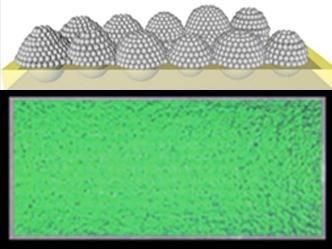Mimicking bug eyes could brighten reflective signs and clothes
Advertisement
That bright, reflective coating used on road signs, bicycles and clothing are important safety measures at night. They help drivers get to their destinations while avoiding bicyclists and pedestrians in low-light conditions. Now, inspired by the structure of insect eyes, scientists have developed new materials that could improve the color and effectiveness of these safeguards.

The structure of bug eyes (top) has inspired bright, vividly colored reflective materials (bottom).
American Chemical Society
Retroreflective materials, including some tapes and road paints, work by bouncing light back toward the original source, such as a car's headlights, making them bright and easy to see. Existing retroreflectors are usually made with glass microbeads and microprisms. Dyes, pigments or plastic layers are often added for color; however, they tend to reduce the reflection of light, and the colors can fade over time. Hongta Yang and colleagues turned to the compound eyes of insects for a new way to address these limitations.
The researchers evenly coated an array of glass microspheres with smaller balls of silica. The result is a brilliantly colored, retroreflective material. The color can be adjusted by changing the size of the silica crystals, and brightness can be boosted by adding layers. At 250 nanometers and 40 layers deep, the crystals appeared bright green and reflected more light than commercial coatings with no color. In addition to boosting the brightness of objects for safety reasons, researchers say that by reflecting rather than absorbing light, the material could be applied to buildings to reduce the urban heat-island effect.
Original publication
Other news from the department science

Get the chemical industry in your inbox
By submitting this form you agree that LUMITOS AG will send you the newsletter(s) selected above by email. Your data will not be passed on to third parties. Your data will be stored and processed in accordance with our data protection regulations. LUMITOS may contact you by email for the purpose of advertising or market and opinion surveys. You can revoke your consent at any time without giving reasons to LUMITOS AG, Ernst-Augustin-Str. 2, 12489 Berlin, Germany or by e-mail at revoke@lumitos.com with effect for the future. In addition, each email contains a link to unsubscribe from the corresponding newsletter.




























































